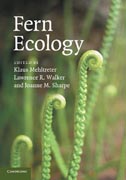
Ferns are an integral part of the world's flora, appreciated for their beautyas ornamentals, problematic as invaders and endangered by human interference.They often dominate forest understories but also colonize open areas, invade waterways and survive in nutrient-poor wastelands and eroded pastures. Presented here is the first comprehensive summary of fern ecology, with worldwide examples from Siberia to the islands of Hawaii. Topics include a brief history ofthe ecological study of ferns, a global survey of fern biogeography, fern population dynamics, the role of ferns in ecosystem nutrient cycles, their adaptations to xeric environments and future directions in fern ecology. Fully illustrated concepts and processes provide a framework for future research and utilization of ferns for graduate students and professionals in ecology, conservation and land management. INDICE: 1. Ecological importance of ferns Joanne M. Sharpe, Klaus Mehltreter and Lawrence R. Walker; 2. Biogeography of ferns Michael Kessler; 3. Ecological insights from fern population dynamics Joanne M. Sharpe and Klaus Mehltreter; 4. Nutrient ecology of ferns Sarah J. Richardson and Lawrence R. Walker; 5. Fern adaptations to xeric environments Peter Hietz; 6. Ferns, disturbance and succession Lawrence R. Walker and Joanne M. Sharpe; 7. Interactions of ferns with fungi and animals Klaus Mehltreter; 8. Problem ferns: their impact and management Roderick Robinson, Elizabeth Sheffield and Joanne M. Sharpe; 9. Fern conservation Klaus Mehltreter; 10. Current and future directions in fern ecology Lawrence R. Walker, Klaus Mehltreter and Joanne M. Sharpe.
- ISBN: 978-0-521-72820-1
- Editorial: Cambridge University
- Encuadernacion: Rústica
- Páginas: 444
- Fecha Publicación: 01/06/2010
- Nº Volúmenes: 1
- Idioma: Inglés
